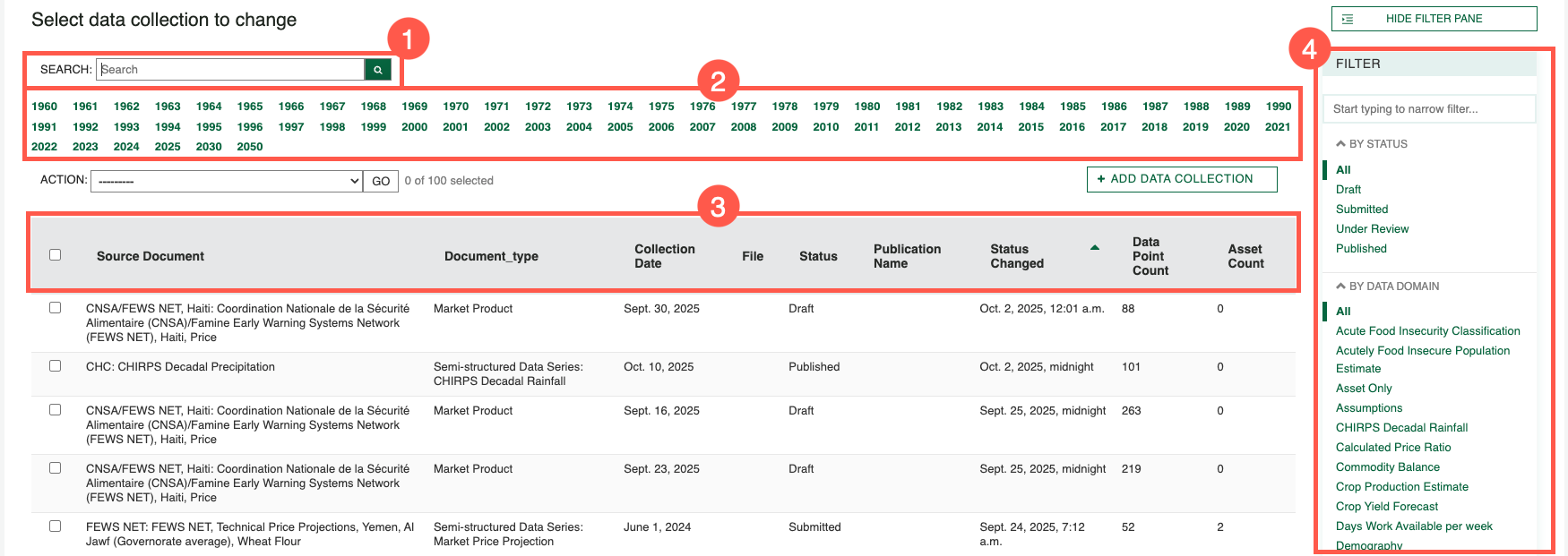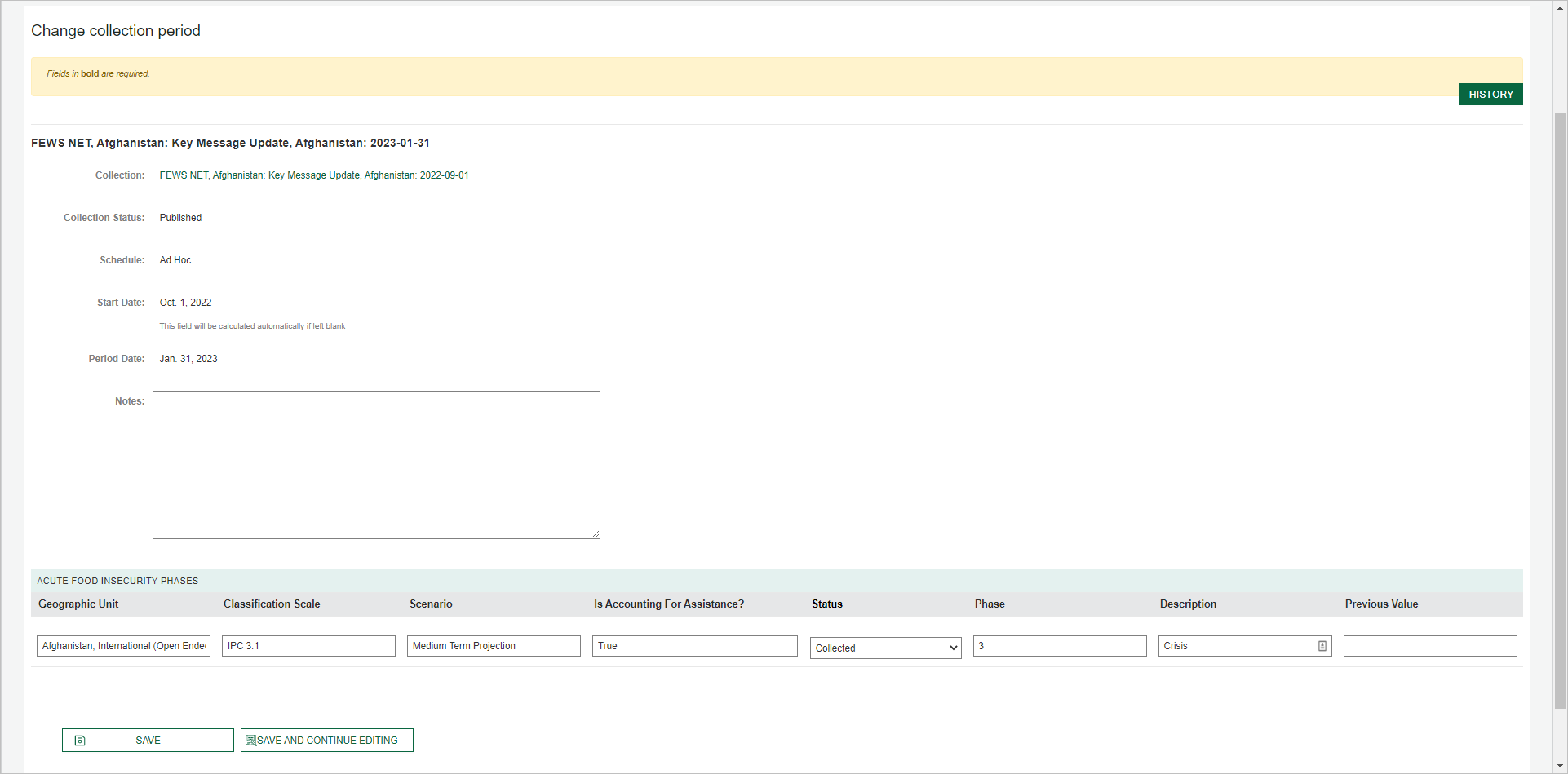Data processing is the second step in the data ingestion process. The Data processing module allows users to review and approve submitted data and Source Documents in preparation for publishing to the FEWS NET Data Warehouse.
Submitted data can be used to build visualizations in the FEWS NET Website CMS. Once published, data becomes available for users with the appropriate permissions to view and export in the FEWS NET Data Explorer.
From the Data processing module, the following actions can be performed:
-
Display or edit an existing Data Collection.
-
Display or edit the data for an existing Collection Period.
Display or edit an existing Data Collection
The Data Collections screen allows you to submit, review, publish, and view an entire Data Collection. A Data Collection is a set of Data Points added in a single import. It may contain multiple Data Series or Collection Periods.
The Data Collections screen lists the currently available collections in a grid format with the following columns:
-
Source Document: The name of the Source Document as defined in the Data entry process.
-
Document Type: The Domain or data type qualification that the data is being submitted under.
-
Collection Date: The Collection Date of the submitted Data Collection.
-
File: Includes a link to the submitted file. Because data can be entered manually, not all collections have a file available.
-
Status: Data collection status types include Draft, Submitted, Under review, and Published.
-
Publication name: The name of the publication that the Data Source Document came from.
-
Status changed: Indicates when the status was last updated.
-
Data Point count: Indicates the file size as represented by the number of Data Points submitted in the Data Collection.
-
Asset count: Indicates the number of assets added to the Data Collection.
Navigating the Data Collections table

Search, sort, and filter the Data Collections table using the following options:
-
Free text criteria search bar: Enter one or more search terms related to the Source Document name, such as the Source Organization or Country.
-
Collection Date year: Select a year to filter Data Collections by a Collection Date year.
-
Sortable columns: Click the column name to sort by it. Multiple columns may be selected. Click the carat to change the sort order. Hover over and click the X next to the column name to remove the column from sorting.
-
Filters: Use the search bar and collapse/expand the filter categories to quickly apply the filters you need. Once a filter is selected from the list, the system will automatically apply the filter and display the results. To remove a selected filter within a filter category, select the All option from the list. Click the CLEAR ALL FILTERS option under the search bar to remove all selected filters.
These options can be used in combination, as demonstrated in the video below.
.gif?cb=0a458982c70a7577596043317b3ca181)
Editing the status information of a Data Collection
The Data Collection status can be changed in two ways:
-
From the table view, use the checkboxes to select one or more data collections and select a status from the Action dropdown:
-
Delete will delete the Data Collection. If deleted, it cannot be recovered.
-
Submit will update the status to Submitted.
-
Publish will update the status to Published.
-
Review will update the status to Under review.
-
-
Select the Data Collection from the table to navigate to the Change Data Collection screen.
-
Modify the data in the Change Data Collection page as needed and select a Save option.
-
Select Submit (for Data Collections in Draft or Under review status) or Review (for Data Collections that are Published).
-

Viewing the change history of a Data Collection
When various events are performed against data within a Data Collection, including the addition of new data, updates, and deletion of data in the system, they are tracked for auditing purposes.
To view the change history of a Data Collection:
-
Select the Data Collections for which the change history is needed.
-
Locate and select the History button.

Display or edit the data for an existing Collection Period
The Collection Periods screen allows you to view and edit a single Collection Period.
The Collection Periods screen lists the currently available collections in a grid format with the following columns:
-
Collection: The name of the Data Collection as defined in the Data entry process.
-
Start date: The date the Collection Period begins.
-
Period date: The date the Collection Period ends.
-
Schedule: The schedule on which the data is collected.
-
Collection status: Status types include Draft, Submitted, Under Review, and Published.
-
Status changed: Indicator of when the status was last updated.
-
Data Point count: The number of Data points included in the Collection Period.
View and edit a Collection Period
To view and edit a Collection Period:
-
Select the Collection Period to be updated.
-
On the Change Collection Period page, you can:
-
Add notes to a Collection Period.
-
View the history of the Collection Period.
-
Edit the status and values of specific Data Points within the Collection Period.
-
-
Select one of the Save options.
